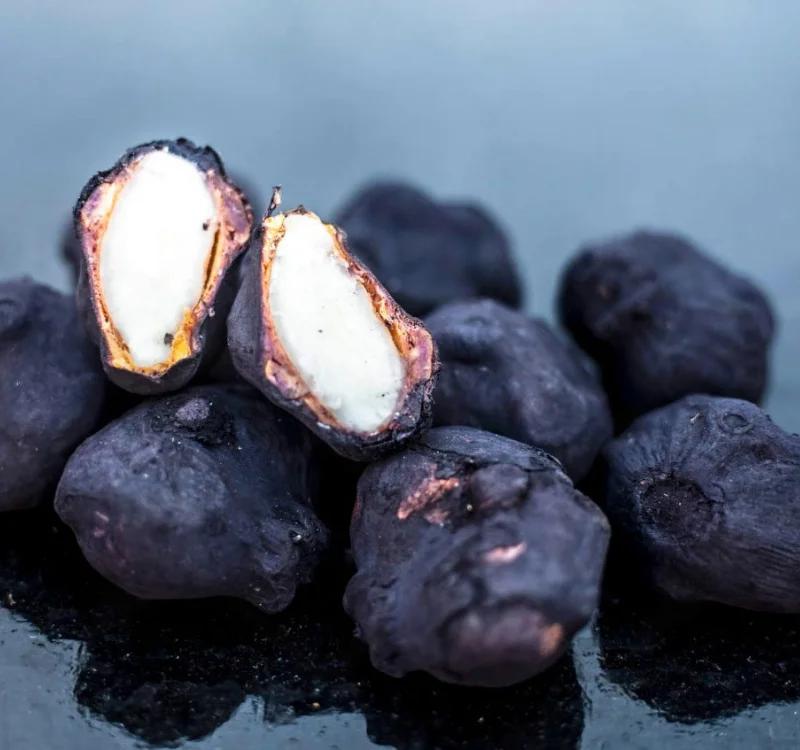Dive into the Top 5 Surprising Benefits and Uses of Singhara Fruit
Oct 01, 2024

Singhara, or water chestnut, is a rare fruit that grows in freshwater lakes and ponds. It's popular in India during fasting because of its high energy and nutritional value. Singhara has a slightly sweet taste and a crunchy texture.
Table of Contents:
- The Nutritional Power of Singhara.
- Top 5 Most Effective Benefits of Singhara Fruit.
- How Can You Use Singhara in Your Daily Life?
- Conclusion.
- FAQs.
People like it cooked, uncooked, or even mixed into flour to use in other recipes. For those searching for a natural and healthful snack, this is a wonderful choice. This little green fruit has several health benefits and is a great source of essential minerals. It is perfect for managing weight because it is minimal in calories. Moreover, people with gluten intolerance can consume it because it is naturally gluten-free. We shall examine the nutritional worth, advantages, and various uses of Singhara to understand why it is considered a superfood.
The Nutritional Power of Singhara
It is full of vital nutrients, singhara fruit is a healthy option for people of all ages. It has a high carbohydrate content, which gives the body rapid energy. It's a well-liked food during fasting because of this. Additionally, it has a good amount of dietary fiber, that helps in digestion and increases feelings of fullness.
Potassium is a key nutrient in singhara that helps maintain healthy blood pressure levels. Important antioxidants that protect the body from damaging free radicals are also present in it. These antioxidants lower the risk of chronic illnesses and strengthen the immune system. Moreover, vitamin B6 is present in singhara, which is necessary for the health of the brain and the synthesis of red blood cells.
The fruit is a heart-healthy snack because it is low in fat and cholesterol. It also has small quantities of important minerals including zinc, phosphorus, and magnesium, all of which are important for sustaining general health. You can get a variety of nutrients from singhara without taking in too many calories.
Top 5 Most Effective Benefits of Singhara Fruit
1. Enhances Heart Health: Singhara fruit is excellent for heart health because it is low in fat and cholesterol. Its potassium content lowers the risk of heart disease by helping in blood pressure regulation. A healthy cardiovascular system is also supported by its antioxidants.
2. Increases Vitality: Singhara fruit has a lot of carbs, which provide you with energy quickly. For this reason, it's frequently consumed when fasting or experiencing low energy. The body gets the food it needs from its natural sugars and carbohydrates to stay alert and active.
3. Digestion Aids: Singhara's dietary fiber supports bowel movement, which helps with digestion. It supports a healthy gut and helps in the prevention of constipation. Additionally, fiber keeps you feeling fuller for longer, which can be beneficial for weight management.
4. Enhances Skin Well-Being: Antioxidants and vitamins found in quantity in singhara protect the skin from harm. It fights wrinkles and fine lines and helps keep skin looking radiant. Its anti-inflammatory qualities calm the skin, minimizing inflammation and redness.
5. Improves Brain Activity: Singhara fruit has vitamin B6, which is good for the brain. It helps in the synthesis of neurotransmitters, which are necessary for healthy brain activity. Singhara can enhance mental clarity, focus, and memory when taken regularly.
How Can You Use Singhara in Your Daily Life?
1. As a Snack: Singhara can be eaten raw or boiled as a healthy snack. It’s crunchy and delicious, making it perfect for a quick bite between meals. You can also roast or fry it for added flavor, making it a versatile food option.
2. Singhara Flour for Fasting: Singhara flour is commonly used to make various dishes during fasting. It is gluten-free and can be used to prepare rotis, puris, or pancakes. The flour is also a great alternative for people who are allergic to wheat.
3. In Desserts and Sweets: Singhara flour is often used to make traditional Indian sweets like halwa and laddoos. It adds a unique flavor and texture to these desserts. The flour’s natural sweetness makes it an excellent ingredient for making healthy, low-calorie treats.
4. As a Thickening Agent: Singhara flour can be used as a thickening agent in soups, sauces, and gravies. It adds a smooth texture without altering the taste of the dish. This makes it a good option for those looking for gluten-free options in their cooking.
Conclusion
Singhara fruit is a rich source of nutrients that is not only delicious but also good for your general health. It's an excellent match to any diet because of its capacity to increase vitality, promote heart health, and facilitate better digestion. It can be eaten raw, boiled, or mixed into flour, Additionally, there are many ways to benefit from it. Singhara flour is a great substitute for gluten-free options while preparing a variety of foods, particularly during fasting.Its versatility is increased by its use as a thickening agent and in desserts. Including Singhara fruit in your diet allows you to have a tasty and nourishing meal that promotes your overall health.
Frequently Asked Questions
Yes, singhara is beneficial for females. It supports hormonal balance, thyroid health, pregnancy, digestion, and skin health, while providing essential nutrients like calcium, iron, and antioxidants for overall well-being.
The disadvantages of singhara may include potential allergies in some individuals and limited availability in certain regions.
Yes, singhara (water chestnuts) can aid weight loss. They are low in calories (97 kcal per 100 grams), high in fiber (3 g), and low in fat, which helps control hunger and supports digestion. They provide essential nutrients without adding many calories, making them a great choice for a weight loss diet.
Singhara (water chestnut) is good for digestion, hydration, heart health, boosting energy, skin health, immunity, thyroid support, and weight management, while offering essential nutrients like potassium, calcium, and antioxidants.
The best time to eat singhara is during fasting or as a healthy snack between meals, as it provides quick energy.
Singhara (water chestnut) is low in calories and high in nutrients. Per 100 grams, it contains:
- Calories: 97 kcal
- Carbohydrates: 23.9 g
- Proteins: 1.4 g
- Fats: 0.1 g
- Fiber: 3 g
- Potassium: 584 mg
It's gluten-free, rich in antioxidants, and supports digestion and energy levels.
Boiled singhara is prepared by simply boiling the fruit until tender; it can be enjoyed as a snack or added to various dishes.
Singhara nutrition is rich in carbohydrates, dietary fiber, potassium, and antioxidants, making it a low-calorie, nutritious snack option.
Singhara benefits for males include improved heart health, increased energy levels, and enhanced digestion, making it a great addition to their diet.
Singhara fruit, also known as water chestnut, is a crunchy, slightly sweet aquatic fruit packed with nutrients and commonly consumed during fasting.














